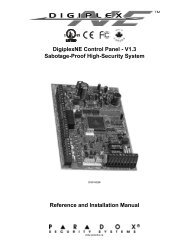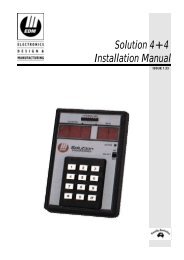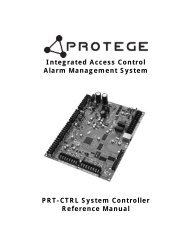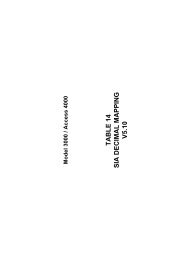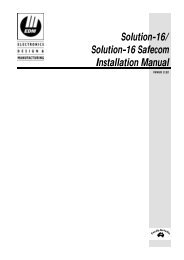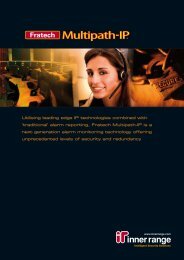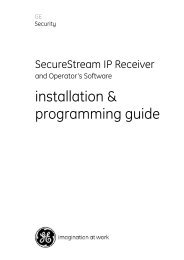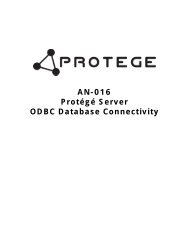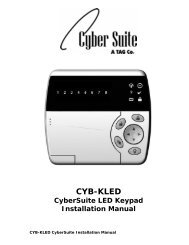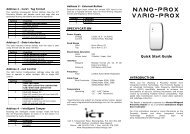IQ Quick Programming Guide V3.604 - Security Help Desk
IQ Quick Programming Guide V3.604 - Security Help Desk
IQ Quick Programming Guide V3.604 - Security Help Desk
Create successful ePaper yourself
Turn your PDF publications into a flip-book with our unique Google optimized e-Paper software.
INNER RANGE <strong>IQ</strong> PLUS. <strong>Quick</strong> Programmer’s Manual.<br />
Version 3.604 (31/03/05) p5<br />
4. ACCESS CONTROL AND THE <strong>IQ</strong> PLUS.<br />
REQUIRED EQUIPMENT.<br />
Enhanced Access Terminal V2.01 or greater; Door strike; Relay board for door strike;<br />
Wiegand reader. The Terminal installation document 635500EN contains additional information<br />
on installation.<br />
DOOR OPTIONS.<br />
The Door (door strike and door reed switch) connected to the Terminal is automatically<br />
associated with that Terminal and can be referred to by the Terminal number, for example;<br />
Terminal 1 = door 1. Terminals can be associated to areas and will only display zone activity<br />
for that Area. (Address 561-564)<br />
All doors will use the same global lock open time (time the door strike is activated) as<br />
programmed at address 909 - Terminal Auxiliary time. This must be programmed to a value<br />
other than 0 for the door to remain open following a valid request to open. If a 0 is left at<br />
this location the lock will open but close again almost immediately, i.e. remain locked.<br />
Valid entries are from 0 to 255 seconds. (Factory default 5 Seconds).<br />
REQUEST TO EXIT BUTTON.<br />
A “Request to Exit” (REX), is typically a button provided to unlock a door from the inside<br />
either bypassing the need to use a reader during low security periods, or because an internal<br />
(exit) reader is not required. The “REX” device can also be a PIR or Photo-Electric beam to<br />
detect the User approaching the door. If a REX button is fitted it will activate the door for the<br />
lock open time (see above). The REX operation is enabled regardless of the state of the<br />
associated Area and is entered into Access Review.<br />
The OFF key can also be used as a REX button if it is programmed at address 918.<br />
ADDING A CARD AND USER PIN.<br />
Once fitted and tested, learning the card (entering the card details into the panel) is done<br />
exactly the same as adding a User PIN with the exception that the card is also presented<br />
(explained in detail in Section 7, the Basic <strong>Programming</strong> <strong>Guide</strong>).<br />
A User can have both a PIN and card, accessing the door using either method. A reader<br />
need not be fitted if PIN only access is required. The door will open for lock open time<br />
following a valid PIN + OFF key.<br />
For higher security applications, both PIN and card can be required to open the door.<br />
This option is global and is set at Address 919.<br />
Each door will assume Area control of the Area associated with the Terminal, a Terminal<br />
MUST be associated with an Area.<br />
The following general rules apply: (see “Access Control” in Section 8)<br />
1) If the User is assigned to an Area that is also associated to the Terminal,<br />
(a)If the Area is armed, presenting a credential (card) will disarm the associated Area and<br />
open the door. (The event is entered into Access Review).<br />
(b) If the Area is disarmed, presenting a credential will open the door. (The event is<br />
entered into Access Review)<br />
2) If the User is not assigned to the Area associated to the Terminal,<br />
(a) If the Area is armed, presenting a credential will not open the door (The event is entered<br />
into Access Review).<br />
(b) If the Area is disarmed, presenting a credential will open the door (The event is entered<br />
into Access Review).<br />
DOOR FORCED<br />
A Door Forced condition is activated when the reed switch goes into alarm without a valid<br />
request to open the door, this also causes the Door Forced system input to go into alarm.<br />
(The event is entered into Access Review)<br />
An Auxiliary can be used to indicate this system input by setting the Auxiliary type; 131<br />
(door1) -138 (door 8) as described in the Tables-Section 10. This Auxiliary will pulse on for<br />
500ms every 5 seconds till cleared. Door Forced is an Alarm condition and is cleared by<br />
using a valid PIN+OFF key.<br />
DOTL<br />
A DOTL (Door open too long) condition is activated when the door is open for longer than a<br />
period of time equal to 4 times that of the lock open time set at Address 909. This means<br />
that once a valid request to open occurs, the lock timer starts and so does the DOTL timer.<br />
Causing the DOTL system input to go into alarm. (The event is entered into Access Review)<br />
An Auxiliary can be used to indicate this system input by setting the Auxiliary type; 141<br />
(door 1) -148 (door 8) as described in the Tables-Section 10. This Auxiliary will pulse on for<br />
500ms every 5 seconds till cleared. DOTL is a warning condition and is cleared by using a<br />
valid PIN + OFF key or a valid card badge.<br />
Door Forced and DOTL system inputs will turn on the fault light on the Terminal and LEDs<br />
15 or 16 when a NEXT 13 is performed. (Refer System Inputs)<br />
The Zones Inputs on terminals are used for door reed switch (zone1) and REX button<br />
(zone2). Each zone must be fitted with the required device or, if not used, must be terminated<br />
with 6k8 resistors. These Zones cannot be used for security zones.



